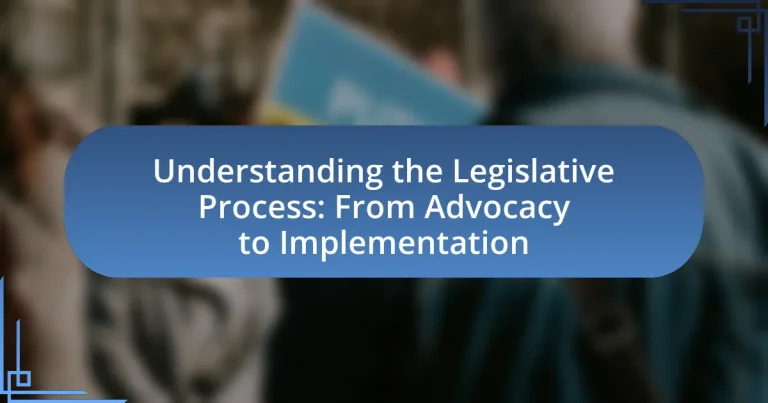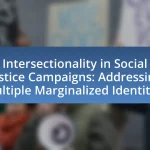The article focuses on the legislative process, detailing how proposed laws, or bills, are introduced, debated, amended, and voted on by legislative bodies such as the U.S. Congress. It outlines the key stages of this process, including bill introduction, committee review, floor debate, and presidential approval. Additionally, the article examines the roles of citizens and advocacy groups in influencing legislation, the impact of public opinion, and the challenges faced during implementation. It also highlights best practices for enhancing the legislative process, emphasizing the importance of transparency, public participation, and effective advocacy strategies.
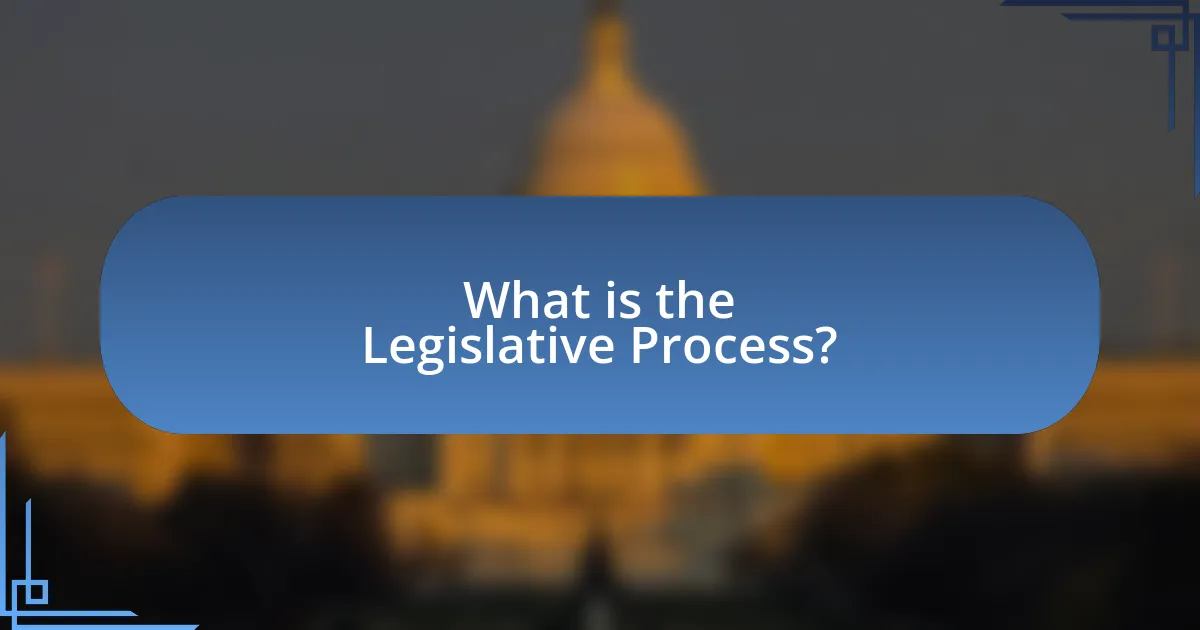
What is the Legislative Process?
The legislative process is the procedure through which proposed laws, known as bills, are introduced, debated, amended, and voted on by a legislative body, such as Congress in the United States. This process typically begins with the introduction of a bill, followed by committee review, floor debate, and voting in both chambers of the legislature. For example, in the U.S. Congress, a bill must pass through the House of Representatives and the Senate before being sent to the President for approval or veto. The legislative process is essential for creating, amending, or repealing laws, ensuring that multiple viewpoints are considered and that legislation reflects the will of the people.
How does the legislative process begin?
The legislative process begins with the introduction of a bill, which can be proposed by a member of the legislature or, in some cases, by the executive branch. This initial step is crucial as it sets the stage for further discussion, debate, and potential amendments. According to the U.S. Congress, a bill must be formally introduced in either the House of Representatives or the Senate, where it is assigned a number and referred to a committee for review. This process is foundational in shaping laws and policies, as it allows for the examination and refinement of proposed legislation before it is brought to the floor for a vote.
What roles do citizens and advocacy groups play in initiating legislation?
Citizens and advocacy groups play crucial roles in initiating legislation by mobilizing public support, raising awareness about specific issues, and influencing policymakers. Citizens can engage in grassroots campaigns, organize petitions, and participate in public forums to express their needs and priorities, thereby creating pressure on legislators to act. Advocacy groups, often equipped with research and expertise, can provide valuable information, draft proposed legislation, and lobby government officials to promote specific policy changes. For example, organizations like the American Civil Liberties Union have successfully influenced legislation related to civil rights by leveraging public opinion and expert testimony. This collaborative effort between citizens and advocacy groups is essential in shaping the legislative agenda and ensuring that diverse voices are heard in the policymaking process.
How do public opinions influence the legislative agenda?
Public opinions significantly influence the legislative agenda by shaping the priorities and actions of lawmakers. When a substantial portion of the electorate expresses strong views on specific issues, legislators often respond by introducing or supporting legislation that aligns with those public sentiments. For instance, research conducted by the Pew Research Center indicates that public opinion can sway legislative outcomes, as seen in the rapid advancement of policies related to climate change and healthcare reform when public concern increased. This responsiveness is driven by the need for elected officials to maintain voter support and ensure re-election, demonstrating the direct correlation between public sentiment and legislative action.
What are the key stages of the legislative process?
The key stages of the legislative process include introduction, committee review, floor debate, voting, and presidential approval. During the introduction stage, a bill is proposed by a member of the legislature. The committee review stage involves examination and discussion of the bill by a specialized group, which may lead to amendments. Following committee approval, the bill is debated on the floor of the legislative body, where further modifications can occur. After debate, a vote is taken; if the bill passes, it moves to the other chamber for consideration. Finally, if both chambers approve the bill, it is sent to the president for approval or veto. This process is essential for ensuring thorough scrutiny and debate of proposed legislation before it becomes law.
What happens during the drafting of a bill?
During the drafting of a bill, legislators or their staff create a formal proposal for new legislation or amendments to existing laws. This process involves researching the issue, consulting with experts, and considering the implications of the proposed changes. The drafted bill is then reviewed for legal language and compliance with existing laws, ensuring clarity and precision in its provisions. Additionally, stakeholders may provide input to refine the bill’s content, which is crucial for addressing the needs and concerns of affected parties. This collaborative effort aims to produce a well-structured document that can effectively advance through the legislative process.
How is a bill introduced and assigned to committees?
A bill is introduced in a legislative body, such as Congress, by a member of that body, typically a legislator who sponsors the bill. Once introduced, the bill is assigned to a committee relevant to its subject matter, which is determined by the legislative rules and the committee’s jurisdiction. For example, a healthcare-related bill would likely be assigned to a health committee. This assignment is crucial as committees conduct detailed examinations of the bill, hold hearings, and may make amendments before deciding whether to advance the bill for further consideration by the full legislative body. The process ensures that bills receive thorough scrutiny and debate before becoming law.
What factors impact the success of legislation?
The success of legislation is primarily impacted by political support, public opinion, and the clarity of the proposed measures. Political support is crucial as it determines the likelihood of a bill being passed through various legislative stages; for instance, bipartisan backing can significantly enhance a bill’s chances, as seen with the Affordable Care Act, which required extensive negotiation and support across party lines. Public opinion also plays a vital role; legislation that aligns with the views and needs of constituents is more likely to succeed, evidenced by the rapid passage of laws related to same-sex marriage as public support grew. Lastly, the clarity and specificity of the proposed measures can influence success; well-defined legislation is easier for lawmakers to understand and advocate for, which was a key factor in the successful implementation of the Clean Air Act, where clear goals and guidelines facilitated bipartisan cooperation.
How do political dynamics affect legislative outcomes?
Political dynamics significantly influence legislative outcomes by shaping the priorities, strategies, and alliances of lawmakers. For instance, the balance of power between political parties can determine which bills are prioritized for discussion and which are likely to pass. In the United States, the majority party in Congress often controls the legislative agenda, allowing them to push through their policy goals while sidelining opposition proposals. Additionally, public opinion and interest group lobbying can sway legislators’ decisions, as elected officials often respond to the preferences of their constituents and influential stakeholders. Historical examples, such as the passage of the Affordable Care Act in 2010, illustrate how party dynamics and public sentiment can converge to produce significant legislative changes.
What role does lobbying play in shaping legislation?
Lobbying plays a crucial role in shaping legislation by influencing lawmakers’ decisions and priorities. Through direct communication, advocacy groups and lobbyists provide information, research, and perspectives that can sway legislative outcomes. For instance, the American Association of Retired Persons (AARP) effectively lobbied for the Medicare Prescription Drug, Improvement, and Modernization Act of 2003, demonstrating how organized lobbying can lead to significant policy changes. This influence is often backed by substantial financial resources, allowing lobbyists to engage in extensive outreach and relationship-building with legislators, thereby ensuring that specific interests are represented in the legislative process.
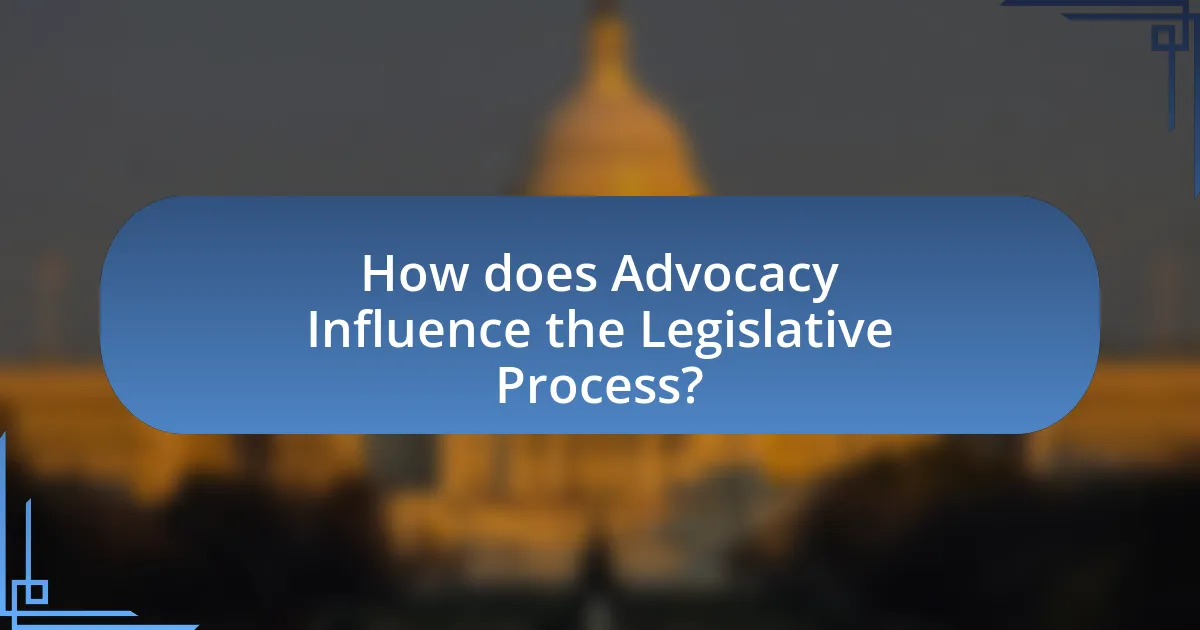
How does Advocacy Influence the Legislative Process?
Advocacy significantly influences the legislative process by mobilizing public opinion and providing lawmakers with information and resources. Advocacy groups often engage in lobbying, which involves direct interaction with legislators to persuade them to support specific policies or legislation. For instance, the American Civil Liberties Union (ACLU) has successfully influenced legislation on civil rights by presenting data and personal stories that highlight the need for legal reforms. This approach not only raises awareness but also creates pressure on legislators to act in accordance with the constituents’ interests, thereby shaping the legislative agenda.
What strategies do advocacy groups use to influence legislation?
Advocacy groups use several strategies to influence legislation, including lobbying, grassroots mobilization, and coalition building. Lobbying involves direct interaction with lawmakers to persuade them to support specific policies or legislation, often employing professional lobbyists who have established relationships with legislators. Grassroots mobilization engages the public to raise awareness and pressure lawmakers through campaigns, petitions, and organized demonstrations, effectively amplifying the group’s message. Coalition building brings together various organizations and stakeholders to present a united front, increasing their collective influence and resources. These strategies are supported by evidence showing that well-organized advocacy efforts can significantly impact legislative outcomes, as seen in successful campaigns for environmental regulations and healthcare reforms.
How do grassroots movements mobilize public support?
Grassroots movements mobilize public support by leveraging community engagement and social networks to raise awareness and drive collective action. These movements often utilize strategies such as organizing local events, utilizing social media platforms for outreach, and creating compelling narratives that resonate with the public’s values and concerns. For instance, the 2018 March for Our Lives, initiated by students advocating for gun control, effectively mobilized thousands through social media campaigns and local rallies, demonstrating the power of grassroots organization in influencing public opinion and policy.
What are the most effective lobbying techniques?
The most effective lobbying techniques include building relationships, providing credible information, and grassroots mobilization. Building relationships with lawmakers fosters trust and facilitates communication, which is essential for influencing policy decisions. Providing credible information, such as data and expert testimonies, helps to substantiate the lobbyist’s position and persuade legislators. Grassroots mobilization engages the public to advocate for specific issues, amplifying the lobbyist’s message and demonstrating widespread support. Research indicates that these techniques significantly enhance the likelihood of achieving legislative goals, as evidenced by successful campaigns that utilized these strategies to influence major policy changes.
Why is coalition-building important for advocacy?
Coalition-building is important for advocacy because it amplifies the voices of diverse stakeholders, increasing the likelihood of achieving policy goals. By uniting various organizations and individuals with shared interests, coalitions can pool resources, share expertise, and enhance credibility, which is crucial in influencing decision-makers. Research shows that coalitions can lead to more effective advocacy outcomes; for instance, a study by the Center for American Progress found that collaborative efforts in advocacy campaigns resulted in a 30% higher success rate in policy changes compared to isolated efforts. This demonstrates that coalition-building not only strengthens the advocacy process but also creates a more powerful platform for change.
How do diverse groups collaborate to strengthen their influence?
Diverse groups collaborate to strengthen their influence by leveraging their unique perspectives and resources to create a unified voice. This collaboration often involves forming coalitions that combine expertise, networks, and advocacy strategies, which enhances their ability to impact policy decisions. For instance, research shows that coalitions representing various demographics can effectively mobilize public support and engage policymakers, as seen in the successful campaigns for civil rights legislation in the 1960s, where diverse organizations worked together to amplify their message and achieve legislative change.
What challenges do coalitions face in the legislative process?
Coalitions face several challenges in the legislative process, primarily including differing priorities among members, communication barriers, and external opposition. Differing priorities can lead to conflicts within the coalition, making it difficult to present a unified front to lawmakers. Communication barriers often arise from the diverse backgrounds and interests of coalition members, which can hinder effective collaboration and strategy development. Additionally, external opposition from rival interest groups or political entities can undermine coalition efforts, complicating the legislative agenda. These challenges can significantly impact the coalition’s ability to influence policy outcomes and achieve their legislative goals.
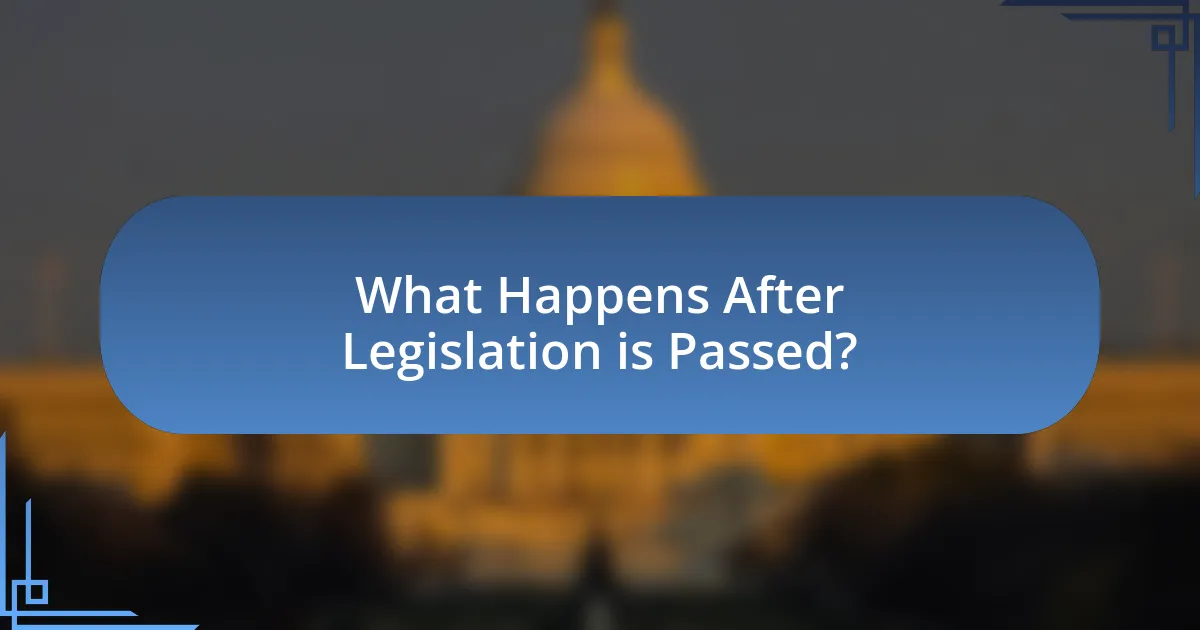
What Happens After Legislation is Passed?
After legislation is passed, it is sent to the executive branch for approval or veto. If the executive signs the legislation, it becomes law and is implemented by relevant government agencies. For example, the Affordable Care Act was signed into law in 2010 and required extensive implementation efforts by the Department of Health and Human Services. If the executive vetoes the legislation, it can still become law if two-thirds of both legislative chambers vote to override the veto. This process ensures that the legislation is either enacted or rejected based on executive approval or legislative consensus.
How is legislation implemented after approval?
Legislation is implemented after approval through a series of steps that involve regulatory agencies, public officials, and the establishment of rules and guidelines. Once a bill is signed into law, the relevant government agency is tasked with developing the necessary regulations to enforce the law, which often includes drafting detailed rules, conducting public consultations, and finalizing the regulations. For example, the implementation of the Affordable Care Act involved the Department of Health and Human Services creating numerous regulations to ensure compliance and effective execution of the law. This process ensures that the legislation is operationalized in a manner consistent with its intended purpose and objectives.
What role do government agencies play in implementation?
Government agencies are crucial in the implementation of laws and policies, as they are responsible for translating legislative mandates into actionable programs and services. These agencies develop regulations, allocate resources, and oversee compliance to ensure that the objectives of the legislation are met effectively. For instance, the Environmental Protection Agency (EPA) implements environmental laws by establishing standards and enforcing regulations to protect public health and the environment. This role is validated by the agency’s ability to conduct inspections, issue permits, and impose penalties for non-compliance, demonstrating their authority and responsibility in the legislative process.
How is compliance with new laws monitored?
Compliance with new laws is monitored through a combination of regulatory agencies, audits, reporting requirements, and enforcement mechanisms. Regulatory agencies, such as the Environmental Protection Agency or the Occupational Safety and Health Administration, are tasked with overseeing adherence to specific laws and regulations. These agencies conduct regular audits and inspections to ensure compliance, while organizations may be required to submit reports detailing their adherence to legal standards. Additionally, enforcement mechanisms, including penalties and legal actions, are employed to address non-compliance, ensuring that entities follow the established laws. This multi-faceted approach helps maintain accountability and promotes adherence to new legislation.
What are the challenges in the implementation of legislation?
The challenges in the implementation of legislation include insufficient resources, lack of coordination among agencies, and resistance from stakeholders. Insufficient resources can hinder the effective execution of laws, as agencies may lack the necessary funding or personnel to carry out their mandates. Lack of coordination among various governmental and non-governmental organizations can lead to fragmented efforts, resulting in inefficiencies and gaps in enforcement. Additionally, resistance from stakeholders, including businesses and community groups, can obstruct the implementation process, as these entities may oppose new regulations or fail to comply with them. These challenges are supported by studies indicating that successful legislation often requires comprehensive planning and collaboration to overcome such barriers.
How do funding and resources affect implementation success?
Funding and resources significantly influence implementation success by providing the necessary financial support and materials required for effective execution. Adequate funding ensures that projects can hire qualified personnel, acquire essential technology, and maintain operational activities, which are critical for achieving desired outcomes. For instance, a study by the National Academy of Sciences found that programs with sufficient funding are 50% more likely to meet their implementation goals compared to those with limited resources. This correlation highlights that without adequate financial backing, even well-designed initiatives may struggle to achieve their objectives, leading to suboptimal results and wasted efforts.
What are common obstacles faced during the implementation phase?
Common obstacles faced during the implementation phase include inadequate resources, lack of stakeholder engagement, and insufficient training. Inadequate resources can hinder the execution of policies, as financial and human capital are essential for successful implementation. Lack of stakeholder engagement often leads to resistance or non-compliance, as key groups may not feel invested in the process. Insufficient training can result in misunderstandings or misapplication of new policies, ultimately affecting their effectiveness. These obstacles are frequently documented in studies examining policy implementation, such as the work by Pressman and Wildavsky, which highlights the complexities and challenges inherent in translating legislative intent into actionable outcomes.
What best practices can enhance the legislative process?
Best practices that can enhance the legislative process include fostering transparency, encouraging public participation, and utilizing data-driven decision-making. Transparency in legislative procedures allows stakeholders to understand the process and hold lawmakers accountable, which can lead to increased trust and engagement. Encouraging public participation through town halls and consultations ensures that diverse perspectives are considered, ultimately leading to more representative legislation. Utilizing data-driven decision-making, supported by empirical evidence and research, can improve the quality of legislation by ensuring that policies are based on proven outcomes and best practices. For instance, studies have shown that jurisdictions with higher levels of public engagement in the legislative process tend to produce more effective and widely accepted laws.
How can advocacy groups effectively engage with lawmakers?
Advocacy groups can effectively engage with lawmakers by establishing clear communication channels and providing well-researched policy recommendations. By presenting data-driven arguments and real-life case studies, advocacy groups can demonstrate the impact of proposed legislation on constituents, thereby making a compelling case for lawmakers to support their initiatives. For instance, a study by the Pew Research Center found that lawmakers are more likely to respond positively to advocacy efforts that include specific statistics and personal stories from their districts, highlighting the importance of tailored messaging.
What strategies can improve public participation in the legislative process?
To improve public participation in the legislative process, strategies such as enhancing transparency, utilizing technology for engagement, and fostering community outreach can be implemented. Enhancing transparency involves making legislative information readily accessible, allowing citizens to understand the process and contribute effectively. Utilizing technology, such as online platforms for public comments and virtual town halls, facilitates broader participation, as evidenced by the increased engagement seen during the COVID-19 pandemic when many legislative bodies adopted remote participation methods. Fostering community outreach through educational programs and partnerships with local organizations can also empower citizens, ensuring diverse voices are heard in the legislative process.
